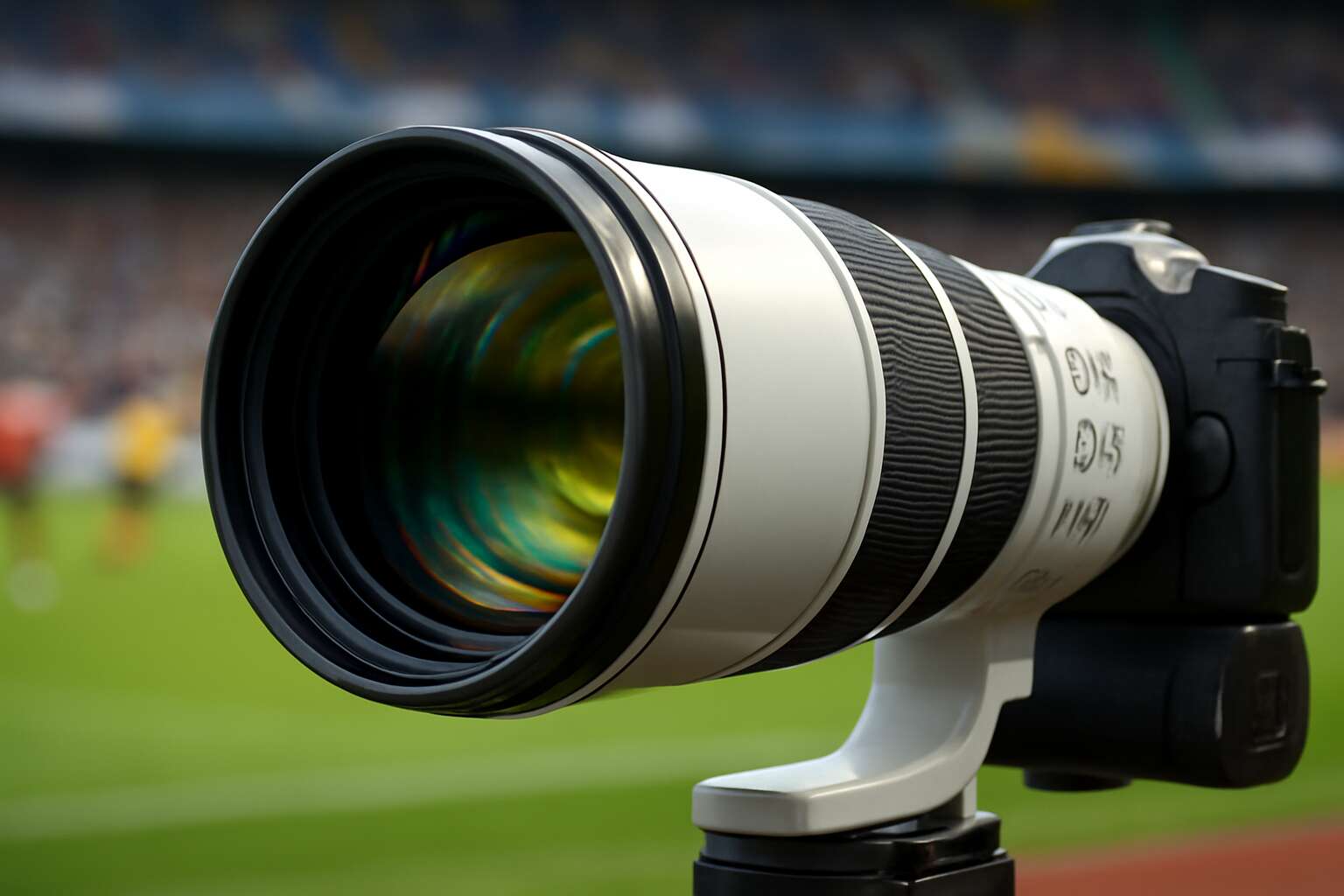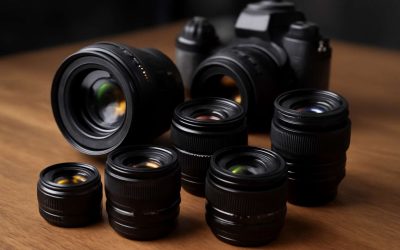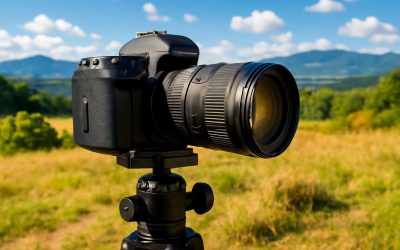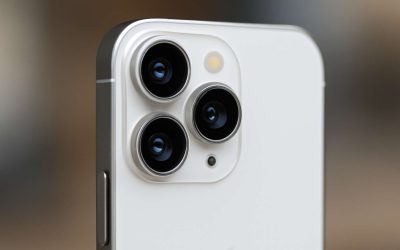Understanding the Importance of the Right Lens for Sports Photography
Overview of Sports Photography Challenges
In the shadowy theatre of sports photography, where fleeting moments vanish like whispers in the wind, the right lens becomes an extension of the photographer’s very soul. Statistics reveal that nearly 70% of successful sports captures hinge upon the choice of a perfect camera lens for sports photography, revealing its paramount importance. Without the correct glass—be it a telephoto or a fast prime—the frantic energy of a race, the raw emotion of a goal, or the delicate grace of an athlete in motion can slip through your grasp, forever lost in the abyss of missed opportunities.
Sports photography demands a lens that can freeze chaos in crystal clarity amidst unpredictable lighting and rapid action. The challenges are many: capturing sharp images at high shutter speeds, maintaining focus on unpredictable subjects, and overcoming the constraints of distance. To navigate this tumultuous landscape, understanding the nuances of camera lenses for sports photography is essential. Often, this means selecting a lens with a wide aperture to let in more light and a focal length capable of reaching distant subjects without sacrificing detail.
- Fast autofocus capabilities
- Vast focal length ranges
- Superior image stabilisation
Each element is a vital thread woven into the tapestry of successful sports imagery, turning fleeting moments into immortalised memories. In this realm of relentless motion and shadowed intensity, the right lens is not just a tool—it’s an oracle, revealing truths hidden in the chaos.
Why Lens Choice Matters
Choosing the correct camera lenses for sports photography is akin to selecting the perfect brush for a masterful painting — it can transform fleeting moments into timeless masterpieces. The right lens does more than just capture an image; it captures emotion, energy, and the very essence of the action unfolding before your eyes. In the chaos of a sprint, a goal, or a soaring leap, a well-suited lens ensures that no detail is lost, no raw intensity left unrecorded.
Why does lens choice matter so profoundly? Because sports photography demands agility and precision. A lens with fast autofocus capabilities allows photographers to keep pace with unpredictable subjects, ensuring each critical moment is sharp and well-focused. From vast focal length ranges that reach across the field or court to superior image stabilisation that mitigates camera shake during rapid movements, each feature enhances the ability to freeze action flawlessly.
Understanding the importance of selecting the right camera lenses for sports photography involves recognising how these tools elevate storytelling. Whether it’s capturing the velocity of a runner or the delicate expression of a goalkeeper, the lens becomes an extension of the photographer’s vision. As such, the choice of lens isn’t merely technical — it’s a philosophical commitment to immortalising the ephemeral, to transforming transient chaos into enduring art.
Key Features to Consider in Sports Lenses
In the realm of sports photography, capturing a fleeting moment with clarity and emotion hinges on more than just skill — it’s about selecting the perfect tool: the right camera lenses for sports photography. These specialised lenses are crafted to meet the unpredictable demands of fast-paced action, ensuring each crucial detail is preserved with precision and vibrancy. The magic lies in understanding which features elevate a lens from good to exceptional in this high-stakes environment.
Key features to consider include a wide aperture, typically f/2.8 or wider, which allows more light to reach the sensor, resulting in sharper images even in challenging lighting conditions. Autofocus speed and accuracy are paramount, enabling the lens to lock onto swiftly moving subjects without hesitation. Additionally, a versatile focal length—often between 70-200mm or 300mm and beyond—provides the reach needed to capture distant moments without sacrificing detail. Image stabilisation further enhances performance, allowing photographers to shoot at slower shutter speeds without introducing blur, especially during handheld shots.
- Fast and reliable autofocus system
- Wide maximum aperture for low-light conditions
- Range of focal lengths suitable for various sports
- Robust build quality for durability in dynamic environments
Types of Camera Lenses Ideal for Sports Photography
Telephoto Lenses – Array
In the realm of sports photography, capturing fleeting moments demands more than just quick reflexes; it requires the perfect camera lenses for sports photography that can freeze action in an instant. Among these, telephoto lenses stand as the unsung heroes, enabling photographers to bridge the distance between the camera and the game with finesse and precision. Their ability to magnify distant subjects transforms a fleeting sprint into a timeless image, revealing details the naked eye might miss.
This array of lenses offers varied focal lengths and apertures tailored to different sporting scenarios. A typical telephoto lens for sports photography might include options such as 70-200mm, 300mm, or even 400mm, each bringing its own unique advantages. The versatility of a 70-200mm lens, for example, makes it a favourite for capturing fast-paced action close to the sidelines, while longer lenses excel at distant, high-stakes moments.
When selecting the ideal telephoto lens, the emphasis often falls on fast autofocus and wide apertures, as these features are crucial for maintaining sharpness amidst unpredictable motion. The right choice can turn a chaotic, adrenaline-charged scene into a beautifully composed shot that encapsulates the thrill of the moment. Truly, the best camera lenses for sports photography are those that marry technical prowess with a poet’s eye for fleeting beauty.
Prime vs. Zoom Lenses – Array
In the dynamic arena of sports photography, the choice of camera lenses for sports photography can make the difference between a fleeting moment lost to the chaos and a stunning image that captures history. Among the myriad options, the debate often centres on prime versus zoom lenses—each a different brushstroke in the artist’s palette. Prime lenses, with their fixed focal lengths, offer uncompromising sharpness and wider apertures, perfect for isolating action with a poetic clarity. They demand a steadier hand but reward with images of exquisite detail.
Conversely, zoom lenses provide a versatile window into the unfolding drama, allowing photographers to swiftly adapt to changing scenes without fumbling with lens swaps. Their ability to seamlessly shift from wide to telephoto focal lengths—such as 24-70mm or 70-200mm—makes them invaluable for unpredictable sporting environments. The choice hinges on the rhythm of the game and the photographer’s instinct, but each lens type, when wielded with mastery, elevates the art of capturing sports through expertly selected camera lenses for sports photography.
Wide-Aperture Lenses – Array
In the shadowed realm of sports photography, where fleeting moments vanish into the ether as quickly as they appear, the choice of lens can spell the difference between obscurity and immortalisation. Wide-aperture lenses emerge as the silent guardians of this craft, allowing photographers to pierce through the chaos and capture the raw intensity of the game. These lenses, with their generous apertures—often f/2.8 or wider—embrace light like a dark lover, illuminating even the murkiest corners of action.
They are the perfect companions for low-light conditions and fast-paced environments, where every second counts. Among these, the 70-200mm f/2.8 lens is legendary, offering a seamless blend of reach and luminosity. The ability to isolate a player or a ball with such poetic clarity transforms the mundane into the magnificent. In the theatre of sports photography, these wide-aperture camera lenses for sports photography are often the crucial element that elevates a good shot into a haunting masterpiece.
Features to Look for in the Best Sports Photography Lenses
Focal Length – Optimal ranges for different sports
Choosing the right focal length for your camera lenses for sports photography can transform fleeting moments into stunning images. The goal is to capture athletes in motion with clarity and emotional impact, which demands an understanding of optimal ranges tailored to different sports. For fast-paced action like football or rugby, lenses with focal lengths between 70-200mm are often ideal, allowing photographers to stay a respectful distance while maintaining tight, impactful shots. Meanwhile, capturing the grace of a sprinter or a swimmer might require longer lenses, such as 300mm or 400mm, to bring distant action into sharp focus without disturbing the scene.
It’s important to consider the typical distances involved in your chosen sport. For indoor sports like basketball or volleyball, a lens with a focal length around 24-70mm can be surprisingly versatile, offering both wide-angle and close-up perspectives. Conversely, outdoor pursuits often benefit from telephoto lenses with focal lengths exceeding 300mm, providing the reach needed to freeze rapid movements at a distance. The right focal length range, combined with other features like fast autofocus and wide apertures, empowers photographers to seize fleeting moments with precision and artistry—hallmarks of exceptional sports photography.
Aperture Size – Maximize brightness and control depth of field
In the fleeting dance of motion and emotion, a lens’s aperture can be the difference between a moment remembered and one lost in blur. The aperture size in camera lenses for sports photography is a vital feature that elevates a shot from mere documentation to an evocative masterpiece. A wide aperture—think f/2.8 or wider—maximises brightness, allowing you to capture crisp, luminous images even amidst challenging lighting conditions. This isn’t just about light; it’s about shaping the depth of field, isolating the athlete from a busy background and creating a visual poetry that commands attention.
For sports where rapid movement is the norm, fast autofocus combined with a wide aperture ensures you don’t miss those fleeting seconds of brilliance. The larger the maximum aperture, the more control you wield over your composition. When selecting camera lenses for sports photography, pay close attention to aperture size—this feature often distinguishes a good shot from a memorable one. After all, in the relentless pursuit of capturing life’s most exhilarating moments, every advantage counts.
Autofocus Speed and Accuracy – Capturing fast-moving subjects
In the relentless pursuit of capturing fleeting moments on the field or court, the speed and precision of your autofocus system can be the difference between a masterpiece and a missed opportunity. The best camera lenses for sports photography are not merely about reach or aperture; they are about the quicksilver responsiveness that keeps pace with lightning-fast moves. When a striker’s foot barely grazes the ball or a sprinter’s stride propels them into glory, your lens must lock onto the subject with unwavering accuracy—like a hawk’s keen eye tracking its prey.
Fast autofocus speed and accuracy are paramount, especially when shooting in unpredictable lighting or crowded environments. Modern sports lenses often feature advanced autofocus motors, such as ultrasonic or stepping motors, which provide near-instantaneous focus adjustments. This technological ballet ensures your camera’s focus remains sharp, even amidst the chaos of dynamic action. For serious sports photographers, selecting lenses with quick autofocus and precise tracking capabilities transforms fleeting seconds into compelling images.
Additionally, some lenses incorporate specialized focus algorithms that optimise performance for tracking fast-moving subjects. These innovations allow you to follow a volleyball smash or a baseball pitch seamlessly, without losing focus or sacrificing image quality. Whether you’re capturing a cyclist hurtling down a track or a footballer weaving through defenders, the ability to react instantaneously is fundamental—making autofocus speed and accuracy the heartbeat of exceptional sports photography.
Image Stabilization – Reducing motion blur during handheld shooting
When it comes to capturing those split-second moments on the field or court, image stabilisation can be your best friend—or your worst enemy—if ignored. Handholding a hefty telephoto lens during fast-paced sports action can introduce unwanted motion blur, turning crisp action shots into fuzzy memories. That’s where advanced image stabilisation technology steps in, diligently reducing camera shake and ensuring your shots stay sharp as a tack.
Modern camera lenses for sports photography often feature sophisticated stabilisation systems, such as Optical Image Stabilisation (OIS) or In-Body Stabilisation (IBIS), which work tirelessly to counteract the jitters caused by rapid panning or unpredictable movement. This technology is particularly vital when shooting in lower light conditions or at longer focal lengths, where even the tiniest tremor can ruin an otherwise perfect shot.
For sports photographers who prefer handheld shooting—because, frankly, lugging a tripod to a football game is about as practical as a screen door on a submarine—image stabilisation isn’t just a luxury, it’s essential. It allows you to maintain a higher shutter speed without sacrificing exposure, resulting in crisp images even amidst the chaos. Remember, in the fast-moving world of sports, every millisecond counts, and stabilisation can make the difference between a blurred mess and a gallery-worthy masterpiece.
Durability and Weather Resistance – Handling outdoor environments
In the unpredictable theatre of outdoor sports, resilience isn’t just a virtue—it’s a necessity. Durability and weather resistance in camera lenses for sports photography become the shield against nature’s whims. When the elements turn wild, a lens that can withstand rain, dust, or sudden temperature drops ensures your creative momentum remains unbroken. It’s about more than just surviving—it’s about thriving amidst the chaos.
Look for lenses boasting robust construction, with weather-sealed barrels and gasketed mounts that prevent rain droplets or dust particles from infiltrating sensitive components. A well-designed weather-resistant lens not only protects your gear but also preserves the clarity of your shots when the skies open up unexpectedly. This is especially vital during outdoor sports events, where unpredictable weather can challenge even the most seasoned photographers.
Some models feature a combination of high-quality materials and innovative sealing techniques, transforming ruggedness into an aesthetic advantage. Remember, investing in the right camera lenses for sports photography that offer enhanced durability ensures your focus remains fixed on capturing fleeting moments, regardless of the weather’s mood swings. Because in the realm of sports, resilience isn’t just a feature—it’s the secret to chronicling victory amidst the storm.
Top Camera Lenses for Sports Photography in 2024
Best Telephoto Lenses – Canon RF continuously 100-500mm, Nikon 70-200mm f/2.8
In the realm of sports photography, where split seconds decide the narrative, choosing the right camera lenses for sports photography can elevate a shot from mundane to magnificent. The year 2024 welcomes a range of exceptional options, but none quite as versatile as the Canon RF 100-500mm lens. Its continuous zoom capability provides unparalleled flexibility, allowing photographers to effortlessly capture high-speed action from a distance without missing a beat.
Similarly, Nikon’s 70-200mm f/2.8 remains a perennial favourite, celebrated for its lightning-fast autofocus and excellent image stabilisation. This lens strikes a perfect balance between reach and clarity, making it an indispensable tool for capturing fast-moving athletes in crisp detail. Whether it’s a sprinter crossing the finish line or a goalkeeper mid-save, these lenses exemplify the quality expected in the best camera lenses for sports photography in 2024.
Best Prime Lenses – Sony FE 85mm f/1.4, Canon EF 50mm f/1.2
In the exhilarating world of sports photography, capturing fleeting moments often feels like chasing whispers in the wind. The right camera lenses for sports photography can transform these ephemeral seconds into eternal images, revealing the poetry in motion. Among the top contenders for 2024 are prime lenses that combine speed, precision, and an almost poetic clarity that elevates sports imagery to art.
The Sony FE 85mm f/1.4 stands out as a favourite for its stunningly shallow depth of field and exceptional autofocus speed. Its luminous aperture renders every bead of sweat and expression of determination with breathtaking clarity. Meanwhile, the Canon EF 50mm f/1.2 offers a different kind of magic—compact yet powerful, it delivers razor-sharp images even in low light conditions, making it a versatile choice for sports photographers who need to adapt rapidly to unpredictable environments.
Both lenses exemplify the allure of prime lenses in the realm of sports photography—where every millisecond counts. Their focal lengths strike a delicate balance, allowing photographers to isolate subjects with dreamy backgrounds or capture intimate moments from a distance. The choice of a prime lens often feels like selecting a finely crafted brush for painting the story of a game; it’s about precision and intent. For those seeking to immortalise the dynamism of the game’s most fleeting moments, these camera lenses for sports photography are nothing short of enchantment in a compact form.
Best Zoom Lenses – Sigma 18-50mm f/2.8, Tamron 70-210mm f/4
In the shadowed realm of sports photography, where milliseconds flicker like fleeting spectres, the right camera lenses for sports photography become the conduit between chaos and clarity. As the adrenaline surges and the crowds roar, capturing those elusive moments demands more than mere skill—it requires tools forged for the relentless chase. Enter the top zoom lenses of 2024, designed to harness the tempest of motion with unwavering precision.
The Sigma 18-50mm f/2.8 stands as a versatile sentinel, its constant aperture illuminating fast-paced scenes with brightness and nuance. Its wide focal range allows photographers to adapt swiftly, whether capturing a sweeping panorama of the game or a ferocious close-up of a striker’s resolve. Complementing this is the Tamron 70-210mm f/4, a glass beast that stretches into the distance, isolating subjects amidst the chaos while maintaining impeccable image quality. Its lightweight form belies the ferocity of its performance, making it an indispensable piece of the arsenal for those who chase fleeting victories through the viewfinder.
- Dynamic focal range spanning wide to telephoto, offering unparalleled flexibility in unpredictable sporting environments.
- Bright aperture to conquer low light conditions, ensuring every detail is rendered with haunting clarity.
- Robust build quality and weather resistance, built to endure the relentless outdoor theatre of athletic spectacle.
These lenses, emblematic of the artful craft of camera lenses for sports photography, invite the photographer into a dance with shadows and light, turning fleeting chaos into eternal artistry. As the shadows lengthen and the game reaches its crescendo, these zoom lenses hold the power to transform wild motion into a symphony of captured moments—an echo in the vast hall of visual memory.
Tips for Choosing the Right Lens for Your Sports Photography Needs
Match Lens to Sport Type – Indoor, outdoor, fast-paced, static
In the realm of sports photography, choosing the perfect lens is akin to selecting a brush for a master painter—each stroke capturing movement, emotion, and fleeting moments with poetic precision. Different sports demand different tools: a fast-paced basketball game calls for lenses that respond with lightning speed, while a static shot of a marathon runner might benefit from a longer focal length to reveal the story in distance.
Match your lens to the sport’s energy and environment. Indoor sports often necessitate wide-aperture lenses to compensate for limited lighting, while outdoor events thrive with telephoto lenses that reach into the distance, freezing an athlete mid-stride. The key is to understand the nuances of each sport—whether it’s the rapid burst of a sprint or the slow, deliberate movement of a golfer—so that your chosen camera lenses for sports photography can bring every moment vividly to life.
Assess Your Camera Compatibility – Sensor size and mount type
When selecting camera lenses for sports photography, compatibility with your camera system is paramount. The sensor size and mount type directly influence the range of lenses you can use effectively. For example, a full-frame camera demands different lens choices than a crop sensor model, affecting both focal length and image quality.
Understanding your camera’s specifications ensures you invest in the right equipment. An incompatible lens not only hampers performance but can also limit your creative potential. To simplify this process, consider making a quick checklist:
- Check your camera’s sensor size (full-frame or crop sensor)
- Verify the mount type (Canon EF, Nikon F, Sony E, etc.)
- Ensure the lens is compatible with your camera’s firmware and features
This foundational step helps you avoid costly mistakes and guarantees that your camera lenses for sports photography will perform optimally, capturing swift action and nuanced detail essential for compelling sports shots.
Budget Considerations – Balancing quality and affordability
Choosing the right lens for sports photography isn’t just about zoom or aperture; it’s about balancing your budget without sacrificing essential performance. High-end camera lenses for sports photography often come with a hefty price tag, but there are surprisingly effective options at more accessible price points. The secret lies in understanding what features truly matter—fast autofocus, wide aperture, and durability—versus bells and whistles that add little real-world benefit.
Consider prioritising lenses that deliver maximum brightness and sharpness within your budget. For example, a mid-range telephoto like the Tamron 70-210mm f/4 offers excellent versatility for outdoor sports without breaking the bank. It’s a dependable choice for capturing fast-paced moments while maintaining cost-efficiency. Remember, investing wisely in your lens selection can make all the difference in your sports photography, especially when every millisecond counts in the shot.
Testing and Rental Options – Trying lenses before buying
Trying out different camera lenses for sports photography before making a purchase can be a game-changer. Many photographers underestimate how much a lens’s behaviour in real-world conditions impacts their shot quality. Testing lenses in a store or renting them allows you to experience their autofocus speed, brightness, and handling firsthand—crucial factors in capturing fleeting moments on the field or court.
Rental options have revolutionised the way sports photographers approach equipment. They provide an affordable way to evaluate a lens’s suitability for your specific needs, whether you’re photographing a fast-paced football match or a static tennis rally. Some rental services even offer trial periods, giving you ample time to assess how a lens performs in different conditions.
When exploring your options, consider the following:
- Does the lens deliver sharp images at the focal length you need?
- How quickly does the autofocus respond during rapid movements?
- Is the lens durable enough to withstand outdoor elements?
Testing and renting lenses for sports photography enables you to make a confident, informed choice—helping you capture those decisive, split-second moments with clarity and precision. It’s an investment that pays off every time you press the shutter button in the heat of the action!
Conclusion
Capturing the thrill of a fast-paced game or the silent intensity of a solo athlete requires more than just a good camera—it’s about choosing the right camera lenses for sports photography. The perfect lens can turn fleeting moments into lasting memories, preserving the raw emotion and split-second action that define sports. Each shot becomes a testament to patience, skill, and a keen eye for detail.
High-quality lenses like telephoto and prime options are essential. They allow photographers to maintain distance while still capturing sharp, vivid images. With advancements in autofocus technology and image stabilisation, these lenses become indispensable tools for sports enthusiasts eager to freeze motion without sacrificing clarity. Whether you’re photographing a football match or a track event, the right lens transforms fleeting seconds into timeless stories.
In essence, selecting the best camera lenses for sports photography isn’t just about equipment; it’s about telling stories through a lens that sees beyond the chaos. It’s about capturing the heartbeat of the game, the determination in an athlete’s eyes, and the fleeting beauty of movement itself. After all, in sports photography, every frame is a victory—waiting to be seized with the perfect lens.




0 Comments